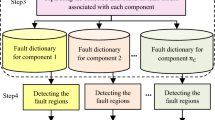Abstract
Starting from a good solution approximation has proved to be very efficient to reduce CPU time required by DC simulation of analog circuits. In order to obtain an additional speedup in DC fault simulation, this paper proposes a new criterion to end the Newton-Raphson (NR) iterative algorithm before convergence. In the case where an initial solution approximation is used, the analysis of the NR algorithm behavior until convergence is presented and a threshold-based simulation accuracy (TBSA) method is then proposed. TBSA stops the iterations when the solution at current NR iteration is enough accurate to immediately classify the fault. According to the detection thresholds, a CPU time/accuracy tradeoff is achieved without altering the fault classification results. The proposed method has been validated on 12 MOS and BJT benchmark circuits considering DC fault simulation under process parameter variations. TBSA is compared to two existing methods which are: standard simulation until convergence method which is accurate but requires a large CPU time, and single NR iteration method which is very fast but without any control over the accuracy. All the compared methods reuse the fault-free circuit results as initial solution for each faulty circuit simulation. It is shown that TBSA requires an intermediate number of NR iterations while achieving correct fault classification, especially for parametric faults which take advantage of using a more accurate initial solution.
Similar content being viewed by others
References
J.S. Augusto and C.F.B. Almeida, “Circuit Equations for Fast Fault Simulation and Diagnosis of Linear Circuits,” IEEE International Conference on Electronics, Circuits and Systems, vol. 1, pp. 125–129, Sept. 1998.
P. Caunegre and C. Abraham, “Achieving Simulation-Based Test Program Verification and Fault Simulation Capabilities for Mixed-Signal Systems,” Proc. of European Design and Test Conference, pp. 469–477, March 1995.
“Circuitsim90,” 1990 Circuit Simulation and Modeling Workshop at MCNC.
G.G.E. Gielen and R.A. Ruterbar, “Computer-Aided Design of Analog and Mixed-signal Integrated Circuits,” Proc. of the IEEE, vol. 88, no. 12, pp. 1825–1854, Dec. 2000.
R.J.A. Harvey, A.M.D. Richardson, E.M.J.G. Bruls, and K. Baker, “Analogue Fault Simulation Based on Layout Dependent Fault Models,” Proc. of International Test Conference, pp. 641–649, Oct. 1994.
N.B. Hamida, K. Saab, D. Marche, B. Kaminska, and G. Quesnel, “LIMSoft: Automated Tool for Design and Test Integration of Analog Circuits,” Proc. of International Test Conference, pp. 571–580, Oct. 1996.
J. Hou and A. Chatterjee, “Concurrent Transient Fault Simulation for Analog Circuits,” IEEE Trans. Computer-Aided Design of Integrated Circuits and Systems, vol. 22, no. 10, pp. 1385–1398, Oct. 2003.
S.D. Huynh, S. Kim, and M. Soma, “Automatic Analog Test Signal Generation Using Multifrequency Analysis,” IEEE Trans. Circuits and Systems—2, Analog and Digital Signal Processing, vol. 46, no. 5, pp. 565–576, May 1999.
B. Kaminska, K. Arabi, I. Bell, P. Goteti, J.L. Huertas, B. Kim, A. Rueda, and M. Soma, “Analog and Mixed-Signal Benchmark Circuits—First Release,” Proc. of International Test Conference, pp. 183–190, Nov. 1997.
A. Khouas and A. Derieux, “Fault Simulation for Analog Circuits Under Parameter Variations,” J. of Electronic Testing: Theory and Applications, vol. 16, no. 3, pp. 269–278, 2000.
D.M.W. Leenaerts and J.V. Spaandonk, “DC Testing of Analog Integrated Circuits with Piecewise Linear Approximation and Interval Analysis,” Proc. of International Symposium on Circuits and Systems, pp. 1337–1340, May 1993.
R.C. Melville, L. Trajkovic, S.-C. Fang, and L.T. Watson, “Artificial Parameter Homotopy Methods for the DC Operating Point Problem,” IEEE Trans. Computer-Aided Design of Integrated Circuits and Systems, vol. 12, no. 6, June 1993.
L.S. Milor, “A Tutorial Introduction to Research on Analog and Mixed-signal Circuit Testing,” IEEE Trans. Circuits and Systems—2, Analog and Digital Signal Processing, vol. 45, no. 10, pp. 1389–1407, Oct. 1998.
M. Morneau and A. Khouas, “Analysis of DC Simulation Convergence of Nonlinear Analog Circuits with Initial Solution,” IEEE Canadian Conference on Electrical and Computer Engineering, pp. 726–730, May 2005.
T. Quarles, A.R. Newton, D.O. Pederson, and A.S. Vincentelli, SPICE3F User’s Manual, Berkeley, California, USA: University of California, May 1993.
M. Sachdev and B. Atzema, “Industrial Relevance of Analog IFA: A Fact or a Fiction,” Proc. of International Test Conference, pp. 61–70, Oct. 1995.
Spectre Circuit Simulator User Guide, Product version 5.0, San Jose, California, USA: Cadence Design Systems Inc., June 2003.
S.J. Spinks, C.D. Chalk, I.M. Bell, and M. Zwolinski, “Generation and Verification of Tests for Analog Circuits Subject to Process Parameter Deviations,” J. of Electronic Testing: Theory and Applications, vol. 20, no. 1, pp. 11–23, 2004.
Star-HSPICE Quick Reference Guide 2001.4, Fremont, California, USA: Avanti Co., Dec. 2001.
M.W. Tian and C.-J.R. Shi, “Efficient DC Fault Simulation of Nonlinear Analog Circuits,” Proc. of Design, Automation and Test in Europe, pp. 899–904, Feb. 1998.
M.W. Tian and C.-J.R. Shi, “Nonlinear Analog DC Fault Simulation by One-Step Relaxation,” Proc. of 16th IEEE VLSI Test Symposium, pp. 126–131, April 1998.
P.N. Variyam and A. Chatterjee, “FLYER: Fast Fault Simulation of Linear Analog Circuits Using Polynomial Waveform and Perturbed State Representation,” Proc. of 10th International Conference on VLSI Design, pp. 408–412, Jan. 1997.
P.N. Variyam, J. Hou, and A. Chatterjee, “Test Generation for Analog Circuits Using Partial Numerical Simulation,” Proc. of 12th International Conference on VLSI Design, pp. 597–602, Jan. 1999.
J. Vlach and K. Singhal, Computer Methods for Circuit Analysis and Design, USA: Van Nostrand Reinhold Company, 1983.
P.R. Wilson, Y. Kilic, J.N. Ross, M. Zwolinski, and A.D. Brown, “Behavioural Modeling of Operational Amplifier Faults Using Analog Hardware Description Languages,” Proc. of 5th IEEE International Workshop on Behavioral Modeling and Simulation, pp. 106–112, Oct. 2001.
M. Zwolinski, C. Chalk, and B.R. Wilkins, “Analogue Fault Modeling and Simulation for Supply Current Monitoring,” Proc. of European Design and Test Conference, pp. 547–552, March 1996.
Author information
Authors and Affiliations
Corresponding author
Additional information
Editor: S. Mir
Rights and permissions
About this article
Cite this article
Morneau, M., Khouas, A. TBSA: Threshold-Based Simulation Accuracy Method for Fast Analog DC Fault Simulation. J Electron Test 22, 425–436 (2006). https://doi.org/10.1007/s10836-006-9502-x
Received:
Revised:
Published:
Issue Date:
DOI: https://doi.org/10.1007/s10836-006-9502-x




